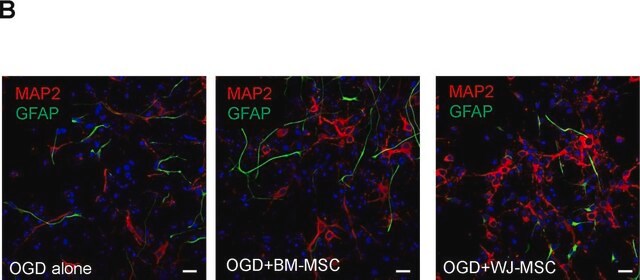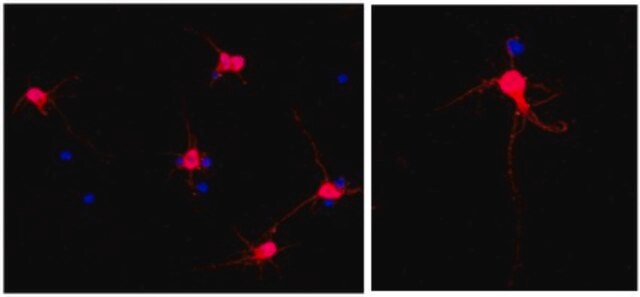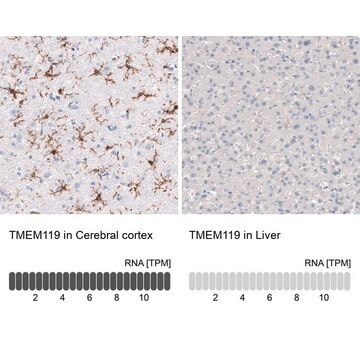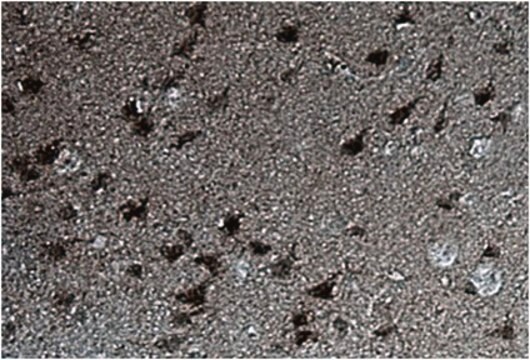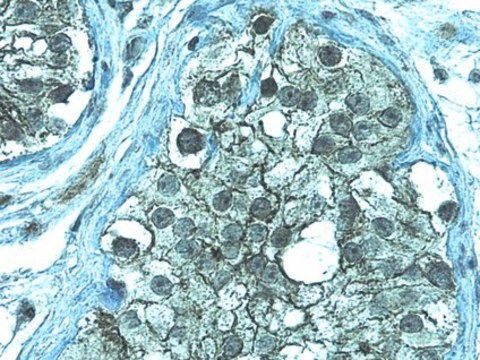MABN2629
Anti-Poly-Neu5Ac Antibody, clone 12E3
Synonim(y):
Kwas N-acetyloneuraminowy, NANA
About This Item
Polecane produkty
pochodzenie biologiczne
mouse
Poziom jakości
forma przeciwciała
purified antibody
rodzaj przeciwciała
primary antibodies
klon
12E3, monoclonal
oczyszczone przez
affinity chromatography
reaktywność gatunkowa
human, mouse
reaktywność gatunkowa (przewidywana na podstawie homologii)
rat
opakowanie
antibody small pack of 100
metody
ELISA: suitable
flow cytometry: suitable
immunoprecipitation (IP): suitable
western blot: suitable
izotyp
IgMκ
sekwencja epitopowa
Unknown
numer dostępu Protein ID
numer dostępu UniProt
temp. przechowywania
-10 to -25°C
Specyficzność
Immunogen
Zastosowanie
Oceniane metodą Western Blotting w jednodniowym ekstrakcie tkanki mózgowej myszy.
Analiza Western Blotting: Rozcieńczenie 1:1000 tego przeciwciała wykryło Poly-Neu5Ac w jednodniowym ekstrakcie tkanki mózgowej myszy.
Testowane aplikacje
Analiza cytometrii przepływowej: Reprezentatywna partia wykryła Poly-Neu5Ac w zastosowaniach cytometrii przepływowej (Davies, L.R.L., et al. (2012). J Biol Chem. 287(34):28917-31).
Analiza Western Blotting: Reprezentatywna partia wykryła Neu5Ac w zastosowaniach Western Blotting (Yabe, U., et al. (2003). J Biol Chem. 278(16):13875-80; Naito-Matsui, Y., et al. (2017). J Biol Chem. 292(7):2557-2570).
Analiza immunoprecypitacji: Reprezentatywna partia wykryła Neu5Ac w zastosowaniach immunoprecypitacji (Yabe, U., et al. (2003). J Biol Chem. 278(16):13875-80).
Analiza ELISA: Reprezentatywna partia wykryła Neu5Ac w zastosowaniach ELISA (Sato, C., et al. (1995). J Biol Chem. 270(32):18923-8).
Uwaga: Rzeczywiste optymalne rozcieńczenia robocze muszą być określone przez użytkownika końcowego jako próbki, a warunki eksperymentalne mogą się różnić w zależności od użytkownika końcowego.
Opis wartości docelowych
Postać fizyczna
Rekonstytucja
Przechowywanie i stabilność
Inne uwagi
Oświadczenie o zrzeczeniu się odpowiedzialności
Nie możesz znaleźć właściwego produktu?
Wypróbuj nasz Narzędzie selektora produktów.
Kod klasy składowania
12 - Non Combustible Liquids
Klasa zagrożenia wodnego (WGK)
WGK 2
Temperatura zapłonu (°F)
Not applicable
Temperatura zapłonu (°C)
Not applicable
Certyfikaty analizy (CoA)
Poszukaj Certyfikaty analizy (CoA), wpisując numer partii/serii produktów. Numery serii i partii można znaleźć na etykiecie produktu po słowach „seria” lub „partia”.
Masz już ten produkt?
Dokumenty związane z niedawno zakupionymi produktami zostały zamieszczone w Bibliotece dokumentów.
Nasz zespół naukowców ma doświadczenie we wszystkich obszarach badań, w tym w naukach przyrodniczych, materiałoznawstwie, syntezie chemicznej, chromatografii, analityce i wielu innych dziedzinach.
Skontaktuj się z zespołem ds. pomocy technicznej